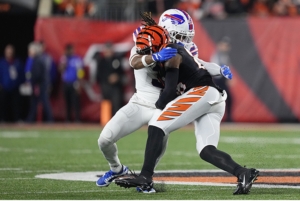On January 2, 2023 like many of you, I was watching the Buffalo Bills vs. Cincinnati Bengals play on Monday Night Football (MNF). At 1755 hrs. PST Damar Hamlin made what seemed to be a routine tackle on Bengals wide receiver Tee Higgins. After the tackle Hamlin immediately stood up, but then fell to the ground flat on his back. I knew immediately that this was something significant, which was quickly confirmed after returning from commercial break to a camera view of the players encircling Hamlin and MNF commentators at a loss for words. The few things they did say were said with a deflated tone.
Over the last two days there have been questions about Hamlin’s vaccination status all over social media. At least in this instance, that information is irrelevant. When you watch the replay, you can clearly see direct contact with Hamlin’s chest. This is a case of commotio cordis, Latin for ‘agitation of the heart.’ Commotio cordis occurs when the chest sustains a blunt force injury, specifically on the anterior left side of the chest during the ventricular repolarization phase of the cardiac cycle causing the heart to go into ventricular fibrillation. The vulnerable phase in the cardiac cycle is 0.1 seconds. But with an increased heart rate there is a increased risk of the event occurring. It is estimated that there are about 30 cases/year, mostly among young male athletes that play baseball. This is the reason that Little League baseball mandates that at least one coach be certified in CPR at every practice and game, and that an AED is available at every game.
The data reports that this event occurs in boys 95% of the time and is thought to occur more commonly because of the choice of sports and the thinner chest wall. The mean age for commotio cordis is 15 years. It is estimated that a baseball traveling at 40 mph is more than enough impact force to generate the needed impact energy of 50 joules. Thankfully, the National Football League (NFL) staffs every game with physicians and paramedics that are prepared for the worst-case scenario. The sideline medical team was beside Hamlin within seconds and after 9 minutes of resuscitative efforts a return of spontaneous circulation (ROSC) was achieved.
Hamlin has survived the first 24-hours, which is a great sign, because as per the American Heart Association (AHA) most deaths after ROSC occur within this timeframe. We are all hoping that Hamlin has a similar outcome has former Philadelphia Flyer Chris Pronger. Pronger sustained the same injury during a hockey game in 1998. Pronger was resuscitated and able to return to playing professional hockey within weeks of the event and went on to play 12 more years, eventually being enshrined in the National Hockey League (NHL) Hall of Fame class of 2015.
References:
Elbaba, J. (2023, Jan. 3). Buffalo Bills’ Damar Hamlin Injury Timeline and Status Update.
Retrieved from https://www.nbcdfw.com/news/sports/buffalo-bills-damar-hamlin-injury-timeline-and-status-update/3161097/.
Guthrie, K. (2019, Sept. 12. Case of Commotio Cordis. Life In The Fastlane. Retrieved from https://litfl.com/case-of-commotio-cordis/.
Staff Writer. (2015, June 29). NHL.com. Chris Pronger elected to Hockey Hall of Fame. Retrieved from https://www.nhl.com/flyers/news/chris-pronger-elected-to-hockey-hall-of-fame/c-772914.
Tainer, C.R. and Hughes, P.G. Commotio Cordis. National Library of Medicine. Retrieved from https://www.ncbi.nlm.nih.gov/books/NBK526014/.
Tanenbaum, Michael. (2023, Jan. 3). Former Flyer Chris Pronger recalls suffering erratic heart rhythm after blow to chest during 1998 game. PhillyVoice. Retrieved from https://www.phillyvoice.com/damar-hamlin-heart-commotio-cordis-chris-pronger-nhl-bills-player-cardiac-arrest/.


